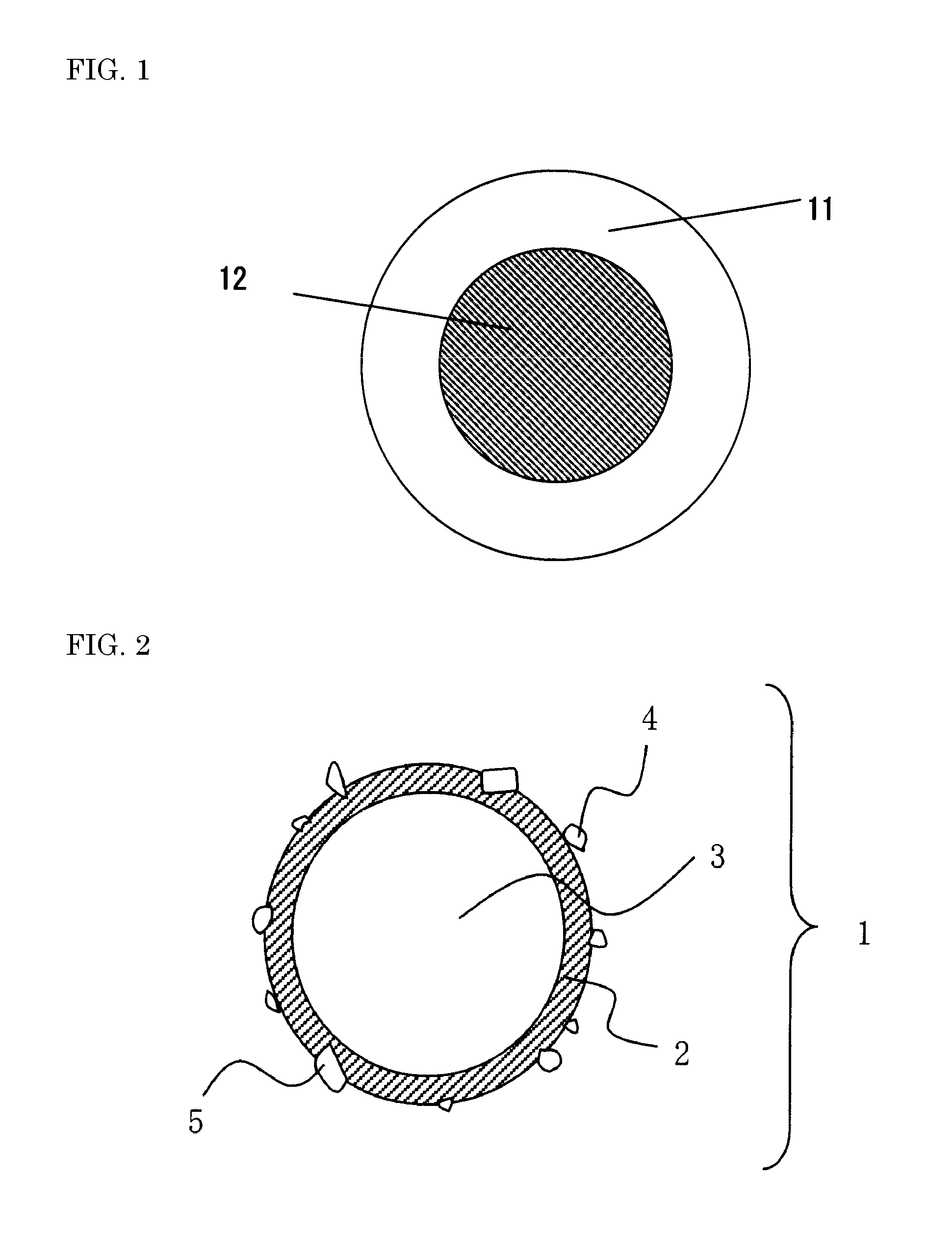Process for producing heat-expandable microspheres and application thereof
a technology of heat-expandable microspheres and microspheres, which is applied in the manufacturing process of electrodes, chemical/physical processes, and the layered product of water-setting substances, etc., can solve the problems of poor dispersibility, apt to agglomerate, and heat-expandable microspheres produced, and achieve good dispersibility and small particle size. , the effect of small particle siz
- Summary
- Abstract
- Description
- Claims
- Application Information
AI Technical Summary
Benefits of technology
Problems solved by technology
Method used
Image
Examples
example 1
[0205]An aqueous dispersion medium was prepared by adding 200 g of colloidal silica dispersion A (containing 20 wt % of colloidal silica having the mean particle size of 5 nm and specific surface area of 550 m2 / g) and 3.0 g of adipic acid-diethanol amine condensate solution (containing 50 wt % of the compound) to 600 g of deionized water and controlling the pH of the mixture at 3.0. The aqueous dispersion medium had the viscosity of 4.4 mPa·s at 20° C.
[0206]An oily mixture was prepared by mixing a monomer component (consisting of 180 g of acrylonitrile, 105 g of methacrylonitrile and 15 g of methyl methacrylate), cross-linking agent (1.5 g of trimethylolpropane trimethacrylate), blowing agent (30 g of isobutane and 30 g of isopentane) and polymerization initiator (2.0 g of 2,2′-azobis (2.4-dimethylvaleronitrile)).
[0207]The aqueous dispersion medium and the oily mixture were mixed and the mixture was agitated with a Homo-mixer at 12000 rpm for 5 min to be prepared into a suspension. ...
example a1
Preparation of Hollow Particles by Wet Thermal Expansion
[0219]An aqueous dispersion (slurry) containing 5 wt % of the heat-expandable microspheres produced in Example 2 was prepared. The microspheres in the slurry were expanded in the wet thermal expansion method described in Japanese Patent Application Publication 1987-201231, where the slurry was fed through a slurry introducing pipe to an expansion tube (specified as SUS304TP in JIS, 16 mm in diameter, 120-ml capacity) at a flow rate of 5 L / min. Steam (at 147° C., of a pressure of 0.3 MPa) was fed to the tube through a steam introducing pipe to be mixed with the slurry so as to thermally expand the microspheres under wet condition. The temperature of the mixture of the slurry and steam was controlled at 115° C.
[0220]The slurry containing the hollow particles was flowed out through the tip of the expansion tube and mixed with cooling water (at 15° C.) to be cooled down to 50 to 60° C. The cooled slurry was dehydrated with a centri...
example of
Production B1
[0231]A slurry composition for the negative electrode was prepared by mixing 100 parts by weight of graphite (MCMB2528, produced by Osaka Gas Co., Ltd.) as the negative electrode active material, 1.0 parts by weight of carboxymethyl cellulose (CELLOGEN 7A, produced by DKS Co., Ltd.) as a viscosity improver, 2.5 parts by weight of a SBR binder (BM-400B, 40 wt % concentration, produced by Zeon Corporation) and 50 parts by weight of deionized water. The slurry composition was applied to the surface of a 20-μm thick copper foil with a Comma coater to make a 150-μm thick film. The slurry was then vacuum-dried at 120° C. for 1 hour, pressed with a pressure ranging from 1×102 to 3×102 N / mm2, and dried in a vacuum oven at 120° C. for 12 hours to be processed into a 80-μm thick negative electrode sheet.
[0232]A slurry composition for the positive electrode was prepared by mixing 100 parts by weight of LiCoO2 having a volumetric mean particle size of 12 μm as the positive electrod...
PUM
| Property | Measurement | Unit |
|---|---|---|
| mean particle size | aaaaa | aaaaa |
| pH | aaaaa | aaaaa |
| mean particle size | aaaaa | aaaaa |
Abstract
Description
Claims
Application Information
 Login to View More
Login to View More - R&D
- Intellectual Property
- Life Sciences
- Materials
- Tech Scout
- Unparalleled Data Quality
- Higher Quality Content
- 60% Fewer Hallucinations
Browse by: Latest US Patents, China's latest patents, Technical Efficacy Thesaurus, Application Domain, Technology Topic, Popular Technical Reports.
© 2025 PatSnap. All rights reserved.Legal|Privacy policy|Modern Slavery Act Transparency Statement|Sitemap|About US| Contact US: help@patsnap.com



